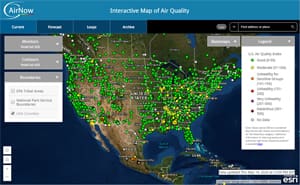As our world stumbles through this painful and unprecedented time, with businesses and schools closed, boat shows canceled and so many of us compelled to shelter in place, it’s frustrating to think that even our boats can only provide limited respite from the draconian restrictions of the pandemic. For the foreseeable future, there’s hardly an island or nation in the world that will welcome foreign recreational boaters without a lengthy quarantine — if at all. I know this is the appropriate action, but still.
Maybe you’ve noticed, however, an unintended consequence of the pandemic — a silver lining. Though the shutdown has crippled the economy, it has brought a windfall to the atmosphere, and we are now experiencing some of the cleanest air and clearest skies in a generation.
It’s not happening because of summer rains, although that sure helps. According to the World Health Organization, before March of this year air pollution was a major health hazard responsible for 7 million deaths annually, with 300,000 of those deaths in the Americas. The root cause is that nine out of 10 people worldwide breathe polluted air. Even way out on Lake Erie we were not insulated from its effects: When sailing into Cleveland, we used to aim for the big hazy smudge on the horizon; sometimes it would rain and, voila! There it was.
Depending on where you live, in the late spring there was a sharp decrease in passenger road traffic of 40 to 50 percent, as reported by transportation analytics company INRIX, whose director of global communications, Mark Burfeind, recently said that “the commute has basically gone away.” Combine that with a significant reduction in power plant production and fewer airline flights, and you have a lot of fossil fuel not being burned.
Since its 2004 launch, NASA’s Aura satellite (its name stemming from the Latin word for “air”) has been used by the agency’s researchers to track ozone, aerosols and key gases in the atmosphere. In May 2020, they reported a 30 percent reduction in nitrogen dioxide — a main contributor to smog — in major metro areas. And, a recent viewing of the AirNow.gov interactive air quality map showed the entire U.S. at a good or moderate level of ozone and particulate matter.
There’s also evidence that the improved air quality could help in the fight against the coronavirus. Researchers at the Harvard T.H. Chan School of Public Health studied 3,000 U.S. counties and concluded that a small increase in long-term exposure to particulate air pollution leads to an increase in risk of dying of COVID-19.
Of course, this salubrious benefit of the pandemic will vanish when the world gets back to “normal.” But still, it’s nice breathing the same kind of air our great-grandparents enjoyed in the early 20th century, even if just for a while.
And when they finally find that vaccine, I’ll be the first one in line with my sleeve rolled up; I’ve got a lot of islands to visit before I’m done.

